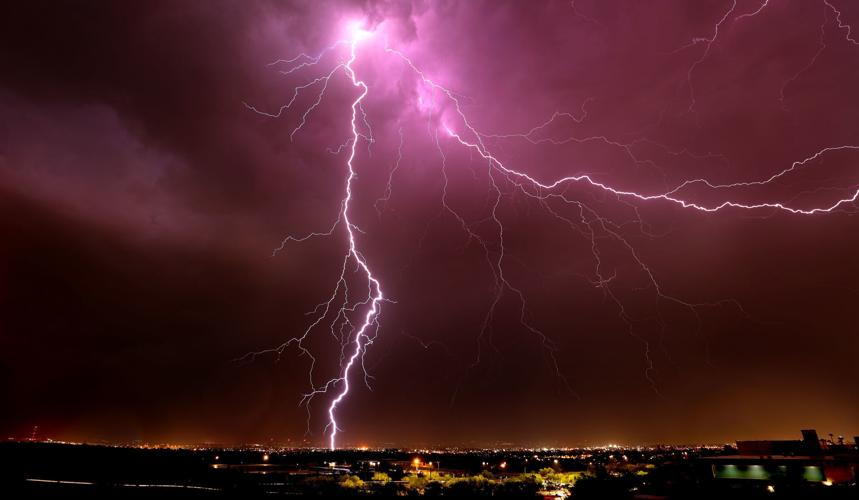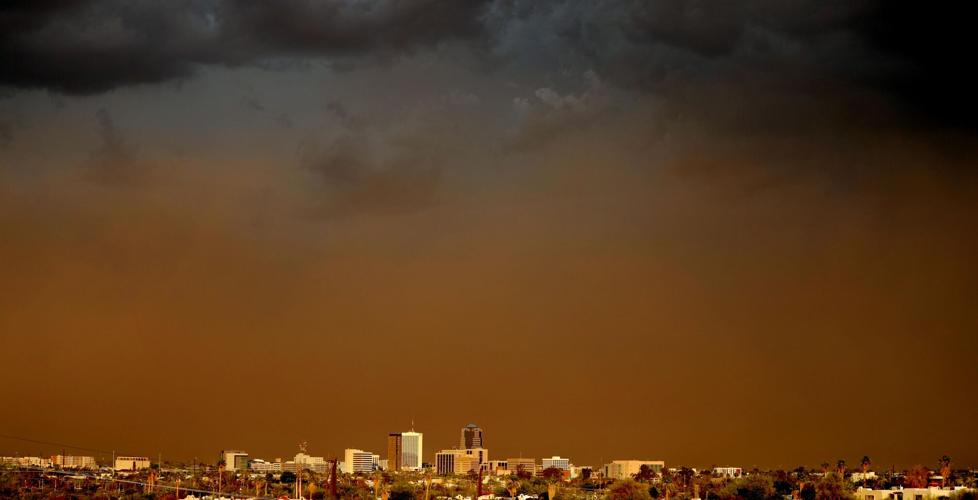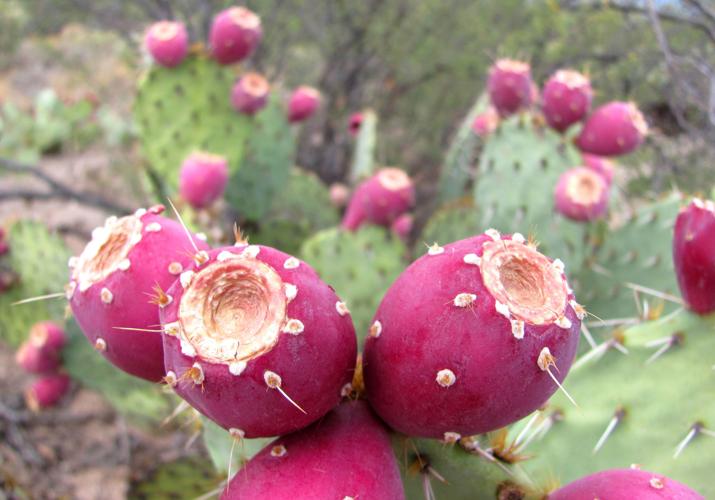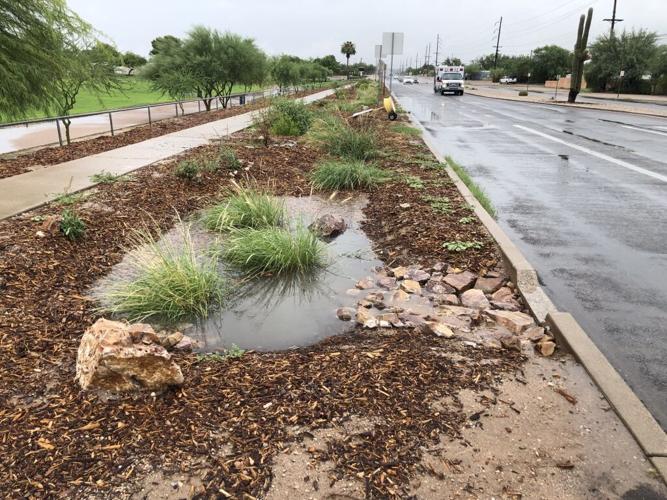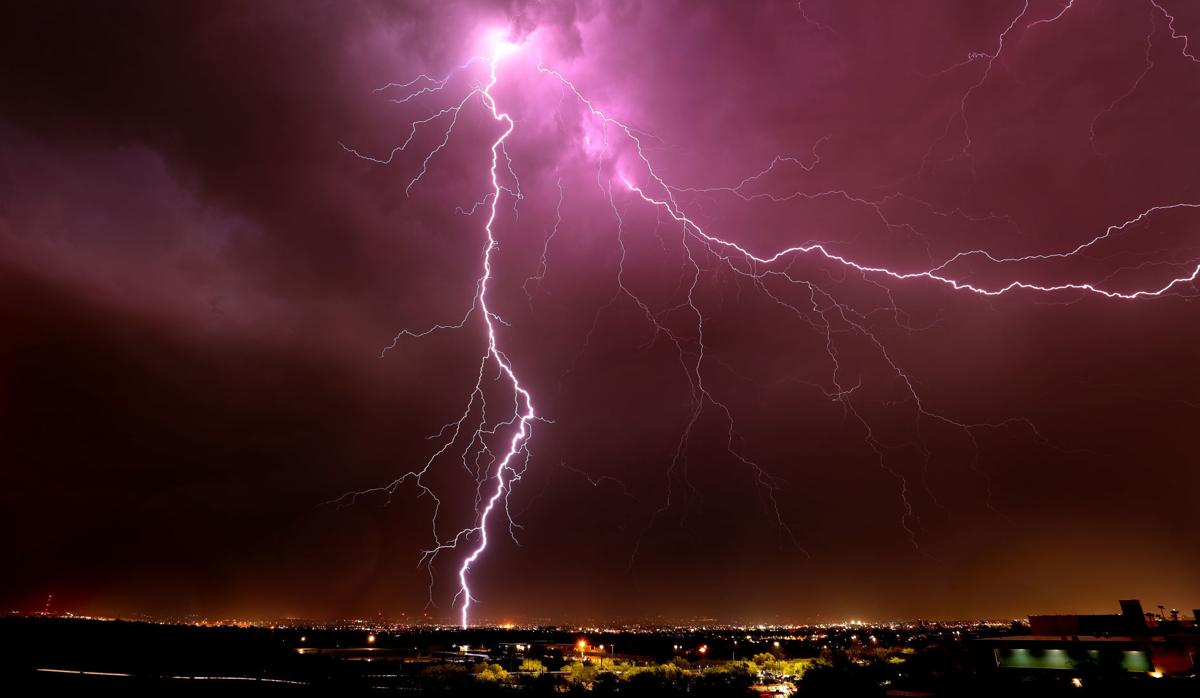Our favorite season has officially started and the monsoon forecast this year looks optimistic.
While you start cheering on the rain, here are some cool facts and tips you need to know about the desert's wet season. Let's start with the fact that about 30-60 percent of Arizona's annual precipitation falls during monsoon season in a normal year, according to the National Weather Service.
1. When does monsoon start?

A highly localized downpour in the foothills of Santa Catalinas just north of downtown as several small but intense cells dropped rain and high winds on the area during the first monsoon storm of the season, Wednesday July 5, 2018, Tucson, Ariz.
Since 2008, the National Weather Service has decreed a monsoon season from June 15 to Sept. 30, but it still keeps track of the monsoon start by a measure it used from 1949 until 2008 — the first of three consecutive days with an average dewpoint of 54 or above.
Also known as chubasco, the summer rains bring much-needed moisture and cooler evenings. Not to mention lightning, heavy rain, high winds, flash flooding, hail and dangerous driving conditions.
2. Driving tips

A disabled car sits in the flooded wash at Copper and Wilson as the waters in the wash rise around it as monsoon finally delvers some rain, Tucson, Ariz., August 10, 2019.
If you're caught in a severe storm and can’t drive safely, move completely off the road and stop with the lights off. Take your foot off the brake to make sure your brake lights are not lit. This prevents other drivers from following your tail-lights, thinking you're still on the road. Never stop in the travel portion of the road.
Pro tips: Replace your windshield wipers before the monsoons start and be sure to check the weather before traveling.
3. Be safe taking those awesome lightning photos

Lightning strikes southeast of downtown as a monsoon storm puts on a light-show but misses with the rain again, Tucson, Ariz., August 22, 2020.
Monsoon lovers should take cover when watching storms. Most lightning strikes usually occur more than three miles away from the center of the thunderstorm, and have even been spotted as far as 15 miles. Some tips to stay safe during nature’s light show include: Stay indoors when you hear thunder, avoid using plumbing and electrical equipment, and keep your distance from windows.
You can keep track of lightning strikes recorded in your area at lightningmaps.org and power outages at tep.com.
4. Watch out for flash flooding

Pedestrians negotiate the flooded intersection of Tyndall Avenue and University Boulevard in Main Gate Square as heavy monsoon rain falls on July 10, 2021.
If your neighborhood looks like it's underwater this time of year, there's a good chance it's because of flash flooding. We have floodplains and plenty of roads and washes that fill quickly with excess rainwater during a good storm.
Avoid getting swept away. Flash floods rank at the top of thunderstorm-related deaths, according to the National Weather Service.
Keep away from rivers and washes during heavy rains. If you're driving and see a flooded area, turn around and plan an alternative route. In most cases, it can be difficult to determine how deep the flood is, and moving water as low as one foot has the ability to carry a car.
Arizona's "Stupid Motorist Law" permits rescue agencies to collect up to $2,000 for water rescues if motorists get stuck after purposely driving in flooded areas.
If you're in a house that is prone to flooding, prepare by storing things above flood level and have items like sandbags and plastic sheeting at hand. It's also best to seek higher ground if possible.
Check out the Monsoon Safety website for more flash flood safety tips.
5. Get out of those dangerous dust storms

A wall of dust dwarfs downtown as a haboob leads a large monsoon storm into the area, Tucson, Ariz., July 10, 2021. In addition to the haboob the storm dropped heavy rain, winds, lightning and dust over the valley.
Any big thunderstorm with high winds, much like the ones seen during monsoon season, has the potential to lift large amounts of dust into the air to form a haboob, or dust storm. And if you've ever seen a photo of an Arizona dust storm, you know they can get intense.
These storms cause problems for motorists as they can happen in a matter of seconds and severely decrease visibility on the road.
The National Weather Service recommends that if you find yourself caught in a dust storm, try to pull your car off the pavement. Stop your car, turn off your lights and set the emergency brake. Be sure to take your foot off the brake pedal, too. If you can't pull off the roadway, drive with caution and at a speed "suitable for visibility, turn on lights and sound horn occasionally." Don't stop on the traveled portion of the road.
Dust storms typically last a few minutes, the weather service says.
6. Say hello to your desert neighbors

Gila Monster.
You could see gila monsters come out to play on nights of high humidity. According to the Arizona-Sonora Desert Museum, gila monsters live in washes that extend down into the valley. They aren't the only ones either: Tarantulas and a wide variety of bugs love this time of year too.
Don't freak out, they're just out enjoying the weather like everyone else.
7. Monsoon season scent

A pair of hikers on the Gabe Zimmerman Trail near Cienega Creek stand out amid creosote and ocotillo revitalized by monsoon rainfall in August 2021.
Have you ever wondered why it smells so good after a rainy day? The smell actually comes from the creosote bush.
It's a plant unique to the Sonoran Desert in Tucson and other dry regions like the Mohave Desert and the Chihuahuan Desert. The plant releases that familiar musky, earthy smell from a coating on its leaves that helps it conserve water.
Tucsonans love it. It's nostalgic because it smells like monsoon season. Ironically, the Spanish name for creosote is hediondilla, which loosely translates to little stinker.
Recently though, a new paper by a trio of researchers says at least 60 different aromatic plants may contribute to what people think of as “the smell of rain” in the Sonoran Desert.
8. End of monsoon is the beginning of prickly pear season

Plump red prickly pear fruits typically ripen in August and are used to make syrups and jellies. But you’ll need permission from a property owner to harvest cactus fruit.
With plentiful rain comes the beautiful green vibrancy of the Sonoran Desert and the ruby red fruit of the prickly pear cactus. This unique fruit, called a “tuna,” grows from the pads of the cactus, creating an amazing edible crown that’s ready to harvest around September. Tunas are used in a variety of foods and products.
But we’re getting ahead of ourselves, learn how to harvest them here.
9. It's a great time to collect rainwater

Students from Flowing Wells Junior High School installed an 800-foot-long rain garden along La Cholla Boulevard last year. The school in partnership with Watershed Management Group plans to expand the garden into four more sections of La Cholla Boulevard by the end of 2022, envisioning a fully green boulevard with water harvesting.
Water from the monsoon storms will definitely fill up those cisterns around town, so much so rainwater collectors can typically use their supplies long after the season is over. If you're interested in setting up your own rainwater collection system, find out how to get started here.
10. You can follow the Tucson Monsoon on Twitter
Yall actually believed I was taking a break....BAHAHAHAHAHAHAHAHAHAHAHAHAHAHAHAHAHAHAHAHAHAHAHAHAHAHAHAHAHAHAH
— TheTucsonMonsoon (@ElTucsonMonsoon) July 11, 2021
Yep, this is a thing. And it’s awesome. You can talk one on one with @ElTucsonMonsoon about everything from rain gauges to weather jokes. But mostly it’s a lot of taunting hot Tucsonans.
Now let's stay safe and enjoy the weather.


